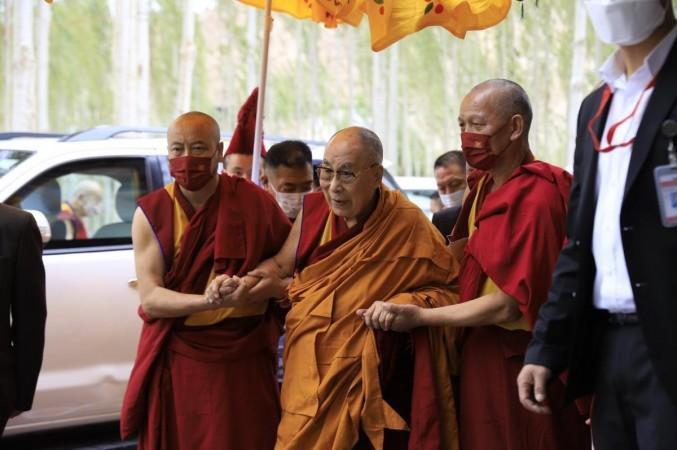Ladakh is the land of the Buddha as some would tend to say. This is mainly due to the predominant Buddhist population in the region who have over the years nurtured values and traditions of Buddhism.
The extensive presence of Mahayana and Vajrayana form of Buddhism in the region has led to the development of an active Buddhist community which emphasises significantly on the essence of Buddhist education, especially culling out core values from ancient Buddhist traditions.
Dotted with a string of beautiful ancient monasteries and Gompas, Ladakh has been the hub of Tibetan Buddhism. The Gompas are centres for intense education programmes in different facets of Buddhism. The people of Ladakh consider His Holiness, the Dalai Lama, the supreme religious leader of Tibetan Buddhism and regard him as the living incarnation of the Buddha.

In this backdrop, the visit of the Holiness to Ladakh is a significant encouragement to the large Buddhist community of Ladakh as also the remaining population who,
irrespective of their background, have a special affection for the Dalai Lama.
Today the mood in Ladakh is one of ecstasy and enthusiasm with the Dalai Lama deciding to spend a good one month in the region.
The people of Ladakh have gone through a difficult phase of transition seeing through the ongoing tension along the border with China with heavy troop and air movement becoming part of their lives.
The Dalai Lama has also not been spared questions from the media on issues that could be rated as 'controversial' or 'challenging'. In the present circumstances, his visit indeed is seen by political strategists as linked to the ongoing tension between India and China along the border.
However, in an effort to remain neutral and not being dragged into any controversy, the Dalai Lama mentioned to reporters that any differences between India and China need to be settled through dialogue and discussion and not through conflict.
He played down the relevance of a standoff-based relationship and instead emphasised the need for the two sides to settle their differences peacefully. His soft and balanced posturing indeed suits all sides and also sends a strong message to the Chinese on his preference for a dialogue and engagement-based approach on controversial issues.

On the topic of Tibet
Speaking on Tibet, the Dalai Lama has reiterated the traditional stand that he and his people have been asking for autonomy as against complete independence of Tibet.
However, he mentioned that there are elements within the Chinese government playing up the Tibet issue linking it with apparent demands for independence by the Tibetans. The Dalai Lama believes that the lack of awareness among ordinary Chinese about the Tibet issue was being exploited by certain elements within the government to portray the Tibetans living outside China as enemies of the nation.
However, he emphasised that the Chinese people were increasingly becoming aware of the realities and the tide was turning against the insidious attempts by some sections in China to portray the Dalai Lama and his followers as anti-China.
During the month-long stay in Ladakh, the Dalai Lama is expected to deliver lectures on a range of issues which are seen as part of his teachings to the community.
These lectures would be attended not only by locals but also by a large number of people from different parts of India and abroad, who would be visiting Ladakh specifically for the purpose.
In the post-pandemic scenario, the Dalai Lama has been cautious in engaging the public keeping in mind his delicate age. The Ladakh visit and meetings scheduled there could be seen as his first breakthrough in public interactions in recent times.
Though much has been written and spoken about the visit taking place in the backdrop of difficult and trying times between India and China on the border issue, the fact remains that the Dalai Lama has been visiting Ladakh quite regularly in the past preaching locals in the region on a variety of specialised subjects.

In 2014, the 79th birthday of His Holiness was celebrated in Leh marked by the 33rd Kalachakra Empowerment event on July 6. In 2018, the Dalai Lama held a two-day teaching on Shantideva's "Guide to the Boddhisattva's Way of Life," which was a follow-up of the teachings imparted by him in Leh in 2017.
One of the major contributions by the Dalai Lama to the region has been the statue of 'Maitreya' (Buddha of the future), which he inaugurated in 2010 at the Diskit monastery.
During this visit, the Dalai Lama remained immersed in a deep teaching regimen focusing on 'Kamalashila', the middle stages of meditation and the Gyalsey Thokme Sangpo's 37 practices of Bodhisattva.
These teaching sessions are eagerly awaited by young students, who aspire to excel in the field of higher Buddhist knowledge, and also by lay persons who eagerly attend his teachings.
On the whole, the present visit by the Dalai Lama to the region is seen as a blessing by the people of Ladakh who also feel that each time His Holiness visits the region, numerous localised problems associated with the weather, the people, the politics of the region are sorted out.
At a personal level, every Buddhist in Ladakh feels that the visit is like a blessing that would do away with their personal problems. For the next month or so, the people of Ladakh would thus be living under the shadow of the Holiness. For His Holiness, there could be no better way than this to remain ensconced within the frame of giving away his rich knowledge to the people of the "little Tibet," as Ladakh is often known.
(With inputs from IANS)














